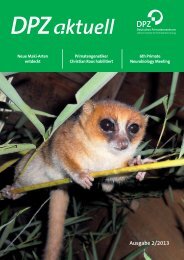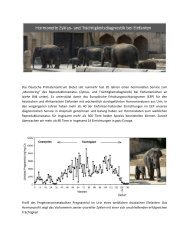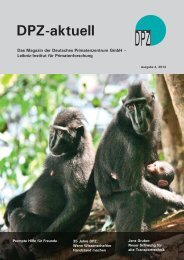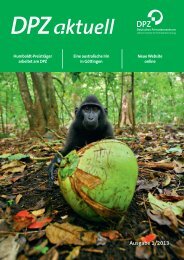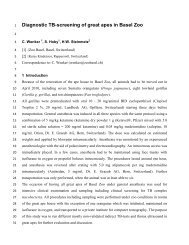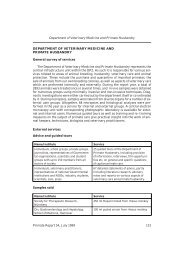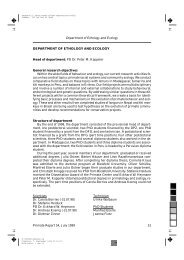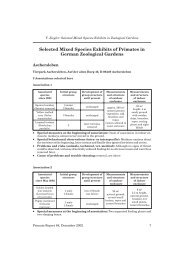Vol. 15 - Deutsches Primatenzentrum
Vol. 15 - Deutsches Primatenzentrum
Vol. 15 - Deutsches Primatenzentrum
You also want an ePaper? Increase the reach of your titles
YUMPU automatically turns print PDFs into web optimized ePapers that Google loves.
Lemur News <strong>Vol</strong>. <strong>15</strong>, 2010 Page 1<br />
Editorial<br />
I am writing this Editorial only a couple of days after another<br />
attempted (and failed) Coup d’Etat in Madagascar,in which a<br />
faction of the army tried to topple the Transition Government.<br />
For nearly two years now, since the start of the political<br />
crisis in early 2009,the country has not seen a week without<br />
demonstrations, tensions between different political<br />
parties and attempts from international mediators to get<br />
power-sharing agreements signed by all sides. Most donors,<br />
governments and multinational organisations alike, have<br />
frozen all non-humanitarian aid for Madagascar,which has led<br />
to severe funding shortages in the environmental and conservation<br />
sector. The political crisis has thus quickly turned<br />
into a full-blown environmental crisis, with large-scale illegal<br />
logging taking place mainly in eastern Madagascar (Marojejy,<br />
Masoala, Makira), and unseen levels of lemur poaching all<br />
across the island.To keep people aware of the seriousness of<br />
the situation we have decided to run another feature on<br />
Madagascar’s environmental crisis in this issue of Lemur News,<br />
with an excellent update on illegal logging by Erik Patel as<br />
well as a case study of ongoing threats to lemurs and their<br />
habitat in Sahamalaza National Park by Melanie Seiler and<br />
colleagues.<br />
The conservation situation of lemurs has also been a big concern<br />
in several presentations given at the most recent 23rd<br />
Congress of the International Primatological Society in<br />
Kyoto, Japan. The talk that I remember best was by Lemur<br />
News co-editor Jonah Ratsimbazafy, who reminded the audience<br />
in a very emotional way that scientists and conservationists<br />
working in Madagascar had a moral responsibility to<br />
respond to the "cries of the lemurs", as otherwise these<br />
would remain unheard by the Malagasy and international<br />
community.In the biennial discussion session of "Primates in<br />
Peril", the list of the world’s top 25 most endangered primates,<br />
issued jointly by the IUCN/SSC Primate Specialist<br />
Group and IPS,lemurs remained a very high priority and will<br />
again make up 20% of the 25 listed species in the next biennium.Sadly,Madagascar<br />
thus retains its first place (along with<br />
Vietnam) as the country harbouring the highest number of<br />
the top 25. It can only be hoped that the political classes of<br />
Madagascar come to agree a way out of the current crisis<br />
sooner rather than later, as otherwise we run the very serious<br />
risk,during the UN Decade of Biodiversity 2011-2020,of<br />
losing a substantial proportion of the endemic biodiversity of<br />
this amazing megadiversity country.<br />
Alison Jolly with Russ Mittermeier at the IPS Lifetime Achievement<br />
Award 2010 ceremony in Kyoto. (Photo: R. Mittermeier)<br />
For a change,on a very positive note,I am thrilled to say that<br />
Alison Jolly was awarded the IPS Lifetime Achievement<br />
Award for her long-term commitment to lemur conservation<br />
and environmental education in Madagascar (see News<br />
and Announcements). My two daughters (now 4 and 2 years<br />
old) and I particularly enjoy reading Alison’s children’s book<br />
on Bitika,the mouse lemur,as,I am sure,do lots of children in<br />
Madagascar and elsewhere in the world.<br />
It is encouraging to see that this volume of Lemur News is<br />
again full of articles and short reports not only on lemur species<br />
red-listed in one of the Threatened categories (VU, EN<br />
or CR),but also on Data Deficient nocturnal species such as<br />
Mirza zaza,Lepilemur leucopus and the recently rediscovered<br />
Cheirogaleus sibreei (see the articles by Rode et al., Fish, and<br />
Blanco, respectively). As Johanna Rode and colleagues point<br />
out in their short report on Mirza zaza,Madagascar is in the<br />
unusual situation that 45 % of its primate species are redlisted<br />
as Data Deficient,which is a far higher percentage than<br />
in any other primate habitat country and mainly derived<br />
from the discovery of dozens of cryptic species in the genera<br />
Lepilemur and Microcebus over the last couple of years. Many<br />
of those species are only known from their type localities<br />
and may in fact be highly endangered. The more research is<br />
conducted and published on them, the easier it will become<br />
to assign them a conservation status and target them with<br />
conservation measures. It will require a concerted effort of<br />
the lemur research and conservation community over the<br />
next decade or so to to reduce the number of Data Deficient<br />
species to a level comparable to other regions (or, ideally, to<br />
zero).<br />
Another encouraging development is the frenzy of research<br />
and conservation activities now under way for Prolemur simus<br />
at various locations both south and north of the Mangoro<br />
River,reported by Dolch et al.as well as Rajaonson et al.in this<br />
volume. The greater bamboo lemur undoubtedly remains<br />
one of the most endangered of Madagascar’s lemurs. However,<br />
with several additional populations having been discovered<br />
over the last two years, workshops having been conducted<br />
that have led to a joint-up approach to this species’<br />
conservation,and the ex situ population having been included<br />
as an integral part of conservation efforts, I now think that<br />
we stand a real chance of saving Prolemur simus from extinction.<br />
As Jörg Ganzhorn announced in his editorial to Lemur News<br />
14, I have taken over the coordination of this newsletter<br />
from him after the 2009 volume, hence this is now the first<br />
volume that I have helped produce (which is my humble excuse<br />
for its slightly late publication). Jörg has been involved<br />
with Lemur News since its inception in 1993,first as a member<br />
of its Editorial Board and from volume 3 (1998) as its Editor.I<br />
am thus pleased to say that we will not lose his experience<br />
and backing,as he has kindly agreed to remain part of the editorial<br />
team. Likewise, Jonah Ratsimbazafy and Rodin Rasoloarison,who<br />
have been the newsletter’s Malagasy coordinators<br />
since 2006, and Anne Yoder, who represents the Duke<br />
Lemur Center, will carry on as editorial team members, for<br />
which I am grateful.I am indebted to Heike Klensang,who has<br />
been doing the layout for Lemur News now for more than a<br />
decade and is still not tired of it,and to Anna Francis,who has<br />
designed the beautiful new logo and front cover. Very many<br />
thanks also to Stephen D. Nash for the wonderful lemur silhouettes<br />
that we printed on the inside back cover.<br />
This volume of Lemur News was kindly supported by the<br />
Margot Marsh Biodiversity Foundation through Conservation<br />
International’s Primate Action Fund, and by the WWF<br />
Madagascar and West Indian Ocean Programme Office.





